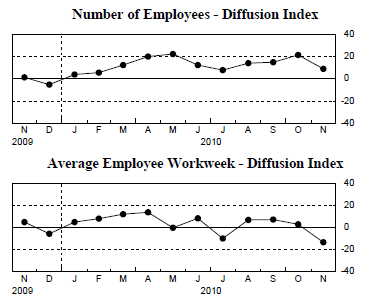NY Fed Manufacturing Survey: New Orders Index Plummets 37 Points to -24.4, Sharpest Drop Since September 2001; Prices Received Negative
Courtesy of Mish
Inquiring minds are investigating the November Empire State Manufacturing Survey for clues about manufacturing and the state of the economy.
The Empire State Manufacturing Survey indicates that conditions deteriorated in November for New York State manufacturers. For the first time since mid-2009, the general business conditions index fell below zero, declining 27 points to -11.1. The new orders index plummeted 37 points to -24.4, and the shipments index also fell below zero.
The indexes for both prices paid and prices received declined, with the latter falling into negative territory. The index for number of employees remained above zero but was well below its October level, and the average workweek index dropped to -13.0.
Business Activity Declines
The general business conditions index fell below zero for the first time since July of 2009, dropping a steep 27 points to -11.1—an indication that, on balance, conditions had worsened over the month. The percentage of respondents reporting that conditions had improved fell from 35 percent in October to just 17 percent in November, while the percentage reporting that conditions had worsened rose from 20 percent to 28 percent.
The new orders index plummeted 37 points to -24.4, its sharpest drop since September 2001. Nearly 40 percent of respondents reported that orders were down. The shipments index fell 26 points to -6.1, and the unfilled orders index declined 23 points to -24.7. The delivery time index, at -9.1, was little changed. The inventories index rose to zero after dropping into negative territory last month.
Price Indexes Fall
Indexes for both prices paid and prices received were below their October levels. The prices paid index fell 8 points to 22.1, suggesting that the pace of price increases had slowed in November. The prices received index dropped below zero, falling 11 points to -2.6 — a sign of slight downward pressure on selling prices. Employment indexes were also lower. The index for number of employees fell 13 points but, at 9.1, remained above zero, indicating that employment levels were modestly higher in November. The average workweek index, however, fell below zero, to -13.0, indicating that the average length of the employee workweek was shorter.
New Orders, Shipments, Unfilled Orders
The new orders index plummeted 37 points to -24.4, its sharpest drop since September 2001. The backlog of orders in conjunction with new orders suggests huge overstaffing issues unless things change quickly.
Employees and Workweeks

The average workweek plunged. Layoffs are next unless conditions change.
Prices Paid vs. Prices Received
For all the brouhaha from inflationists regarding soaring commodity prices and how it means wild-ass inflation, I calmly point out five things.
1. Inflation is about credit and the demand for it, not prices.
2. Pricing power is nonexistent. Similar small business surveys show the same thing. Businesses have not been able to pass along input price increases, and that’s a fact Jack.
3. A business pricing squeeze is on, as consumers demand bargains.
4. Inflation is rampant IN CHINA, not in the US. Commodity prices have far more to do with overheating in China, than anything regarding inflation in the US.
5. Money supply and more importantly credit, is soaring in China. Credit is contracting in the US.
Thus, the rah-rah inflation talk by inflationists cherry picking commodity prices and pretending those prices are a measure of inflation in the US, is complete nonsense, for more reasons than one.
If inflationists want to scream about inflation they should be screaming about China. Instead they run around like chickens with no heads, unable to find any country except the US on a global map.






